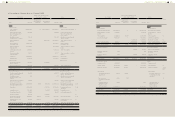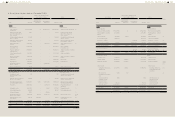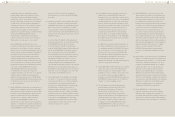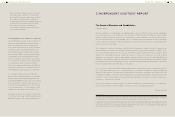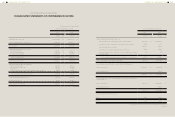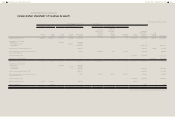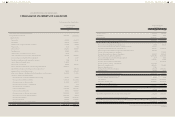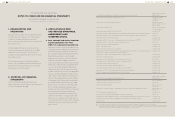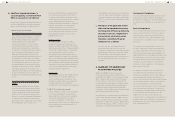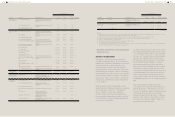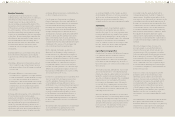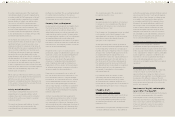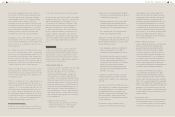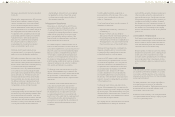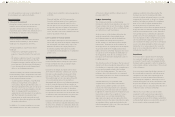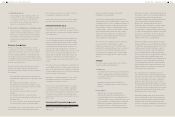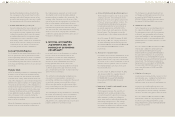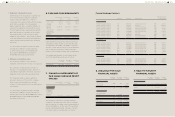HTC 2013 Annual Report Download - page 127
Download and view the complete annual report
Please find page 127 of the 2013 HTC annual report below. You can navigate through the pages in the report by either clicking on the pages listed below, or by using the keyword search tool below to find specific information within the annual report.
FINANCIAL INFORMATION FINANCIAL INFORMATION
250 251
b. Significant impending changes in
accounting policy resulted from New
IFRSs in issue but not yet effective
Except for the following, the initial application of
the above New IFRSs has not had any material
impact on the Company's accounting policies:
1. IFRS 9 "Financial Instruments"
Recognition and measurement of financial assets
With regards to financial assets, all recognized
financial assets that are within the scope of
IAS 39 "Financial Instruments: Recognition
and Measurement" are subsequently
measured at amortized cost or fair value.
Specifically, financial assets that are held
within a business model whose objective is
to collect the contractual cash flows, and that
have contractual cash flows that are solely
payments of principal and interest on the
principal outstanding are generally measured
at amortized cost at the end of subsequent
accounting periods. All other financial assets
are measured at their fair values at the end
of reporting period. However, the Company
may make an irrevocable election to present
subsequent changes in the fair value of an
equity investment (that is not held for trading)
in other comprehensive income, with only
dividend income generally recognized in profit
or loss.
Recognition and measurement of financial
liabilities
As for financial liabilities, the main changes
in the classification and measurement relate
to the subsequent measurement of financial
liabilities designated as at fair value through
profit or loss. The amount of change in the
fair value of such financial liability attributable
to changes in the credit risk of that liability is
presented in other comprehensive income and
the remaining amount of change in the
fair value of that liability is presented in profit
or loss, unless the recognition of the effects
of changes in the liability's credit risk in other
comprehensive income would create or enlarge
an accounting mismatch in profit or loss.
Changes in fair value attributable to a financial
liability's credit risk are not subsequently
reclassified to profit or loss. If the above
accounting treatment would create or enlarge
an accounting mismatch in profit or loss, the
Group presents all gains or losses on that
liability in profit or loss.
Hedge accounting
The main changes in hedge accounting
amended the application requirements for
hedge accounting to better reflect the entity's
risk management activities. Compared with IAS
39, the main changes include: (1) enhancing
types of transactions eligible for hedge
accounting, specifically broadening the risk
eligible for hedge accounting of non-financial
items; (2) changing the way hedging derivative
instruments are accounted for to reduce profit
or loss volatility; and (3) replacing retrospective
effectiveness assessment with the principle of
economic relationship between the hedging
instrument and the hedged item.
Effective date
The mandatory effective date of IFRS 9, which
was previously set at January 1, 2015, was
removed and will be reconsidered once the
standard is complete with a new impairment
model and finalization of any limited
amendments to classification and measurement.
2. IFRS 13 "Fair Value Measurement"
IFRS 13 establishes a single source of guidance
for fair value measurements. It defines fair
value, establishes a framework for measuring
fair value, and requires disclosures about
fair value measurements. The disclosure
requirements in IFRS 13 are more extensive than
those required in the current standards. For
example, quantitative
and qualitative disclosures based on the three-
level fair value hierarchy currently required for
financial instruments only will be extended by
IFRS 13 to cover all assets and liabilities within
its scope.
c. The impact of the application of New
IFRSs and the Regulations Governing
the Preparation of Financial Reports by
Securities Issuers (the "Regulations")
in issue but not yet effective on the
Company's consolidated financial
statements was as follows:
As of the date the consolidated financial
statements were authorized for issue, the
Company is continuingly assessing the possible
impact that the application of the above New
IFRSs will have on the Company's financial
position and operating result, and will disclose
the relevant impact when the assessment is
complete.
4. SUMMARY OF SIGNIFICANT
ACCOUNTING POLICIES
On May 14, 2009, the FSC announced the
"Framework for the Adoption of IFRSs by the
Companies in the ROC." In this framework, starting
2013, companies with shares listed on the Taiwan
Stock Exchange or traded on the Taiwan GreTai
Securities Market or Emerging Stock Market should
prepare their consolidated financial statements in
accordance with the Regulations Governing the
Preparation of Financial Reports by Securities Issuers
and the IFRSs approved by the FSC.
The Company's consolidated financial statements
for the years ended December 31, 2013 is its first
IFRS consolidated financial statements. The date
of transition to IFRSs was January 1, 2012. Refer to
Note 40 for the impact of IFRS conversion on the
Company's consolidated financial statements.
Statement of Compliance
The consolidated financial statements have been
prepared in accordance with the Regulations
Governing the Preparation of Financial Reports by
Securities Issuers and IFRSs as endorsed by the
FSC.
Basis of Preparation
The consolidated financial statements have been
prepared on the historical cost basis except for
financial instruments that are measured at fair
values. Historical cost is generally based on the
fair value of the consideration given in exchange
for assets.
The opening consolidated balance sheet as of
the date of transition to IFRSs was prepared in
accordance with IFRS 1 - First-time Adoption of
International Financial Reporting Standards. The
applicable IFRSs have been applied retrospectively
by the Company except for some aspects where
other IFRS 1 prohibits retrospective application
or grants optional exemptions to this general
principle. For the exemptions of the Company,
please refer to Note 40.
For readers' convenience, the accompanying
consolidated financial statements have been
translated into English from the original Chinese
version prepared and used in the Republic of
China. If inconsistencies arise between the English
version and the Chinese version or if differences
arise in the interpretations between the two
versions, the Chinese version of the consolidated
financial statements shall prevail. However, the
accompanying consolidated financial statements
do not include the English translation of the
additional footnote disclosures that are not
required under accounting principles and practices
generally applied in the Republic of China but are
required by the Securities and Futures Bureau for
their oversight purposes.


